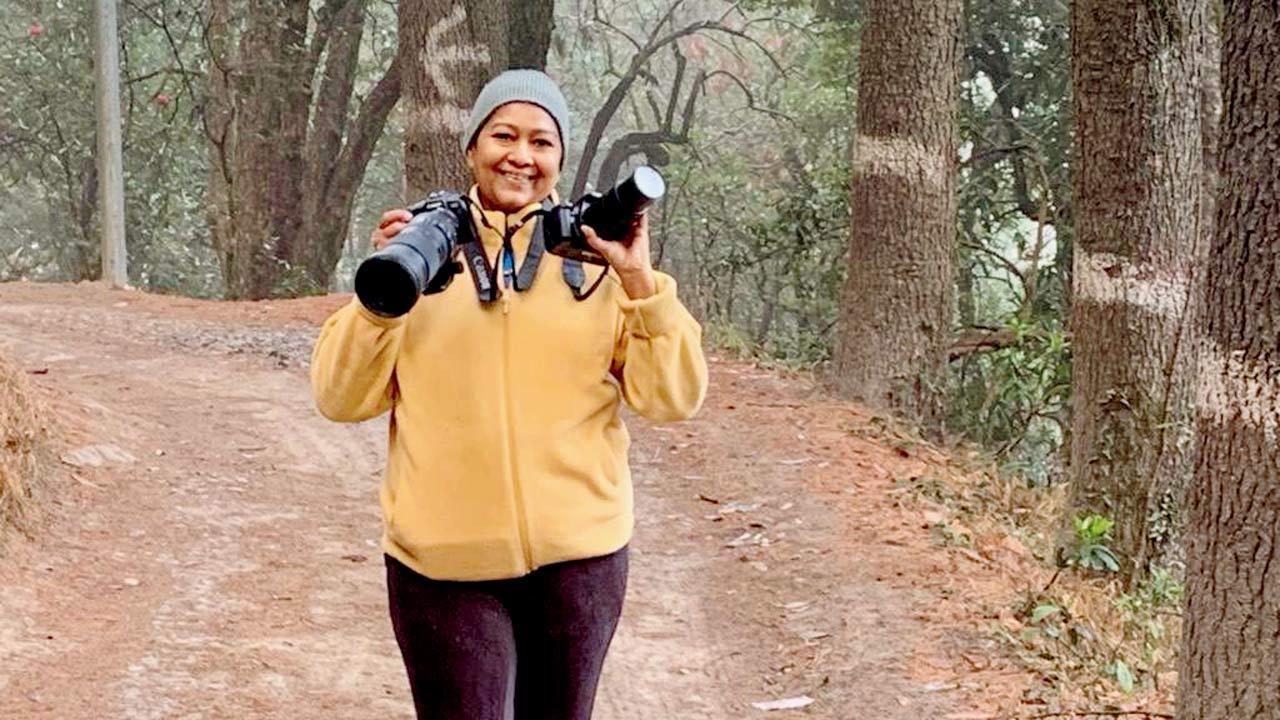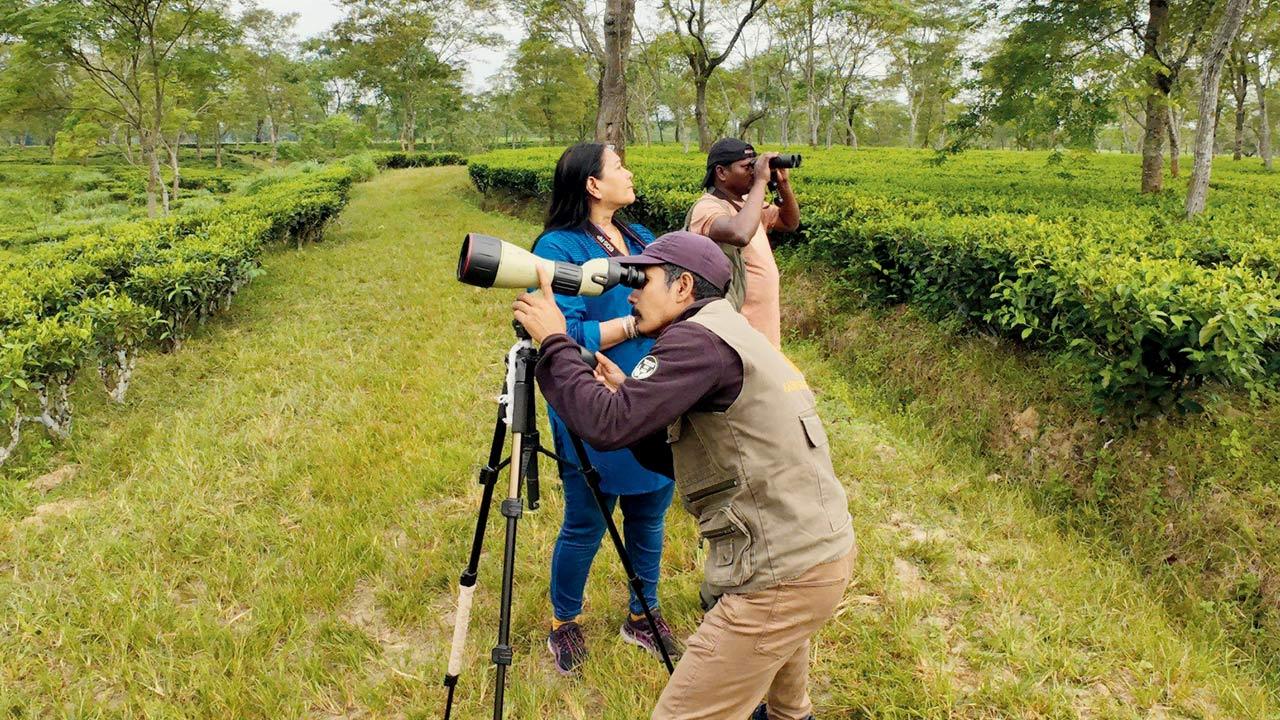Poet-birder Vinita Agrawal puts the spotlight on ravaged landscapes and vulnerable species in a new anthology on Earth’s current status

Vinita Agrawal takes in the sights at Mukteshwar, Uttarakhand. She describes herself as a ‘poet naturalist’ who has travelled extensively in India, especially in the Himalayan region
![]() A “blood and bones farmer” in Hanuthang, north of Ladakh enroute to Nubra valley, hopelessly surveys his decayed apricot crop. Tenzin, 65, is in tears. He hopes and prays for migratory birds—thrushes, plovers, stints, wheatears—which annually fly in to eat the aphids, mealybugs and other pests that devour the crop. But there have been no birds for a few years now; they cannot migrate due to the rising temperatures. For no fault of his own, Tenzin’s farm is at the receiving end of global warming, which has adversely impacted the Central Asian Flyway (CAF), one of the nine global aerial routes used by migratory birds, covering 30 countries including India.
A “blood and bones farmer” in Hanuthang, north of Ladakh enroute to Nubra valley, hopelessly surveys his decayed apricot crop. Tenzin, 65, is in tears. He hopes and prays for migratory birds—thrushes, plovers, stints, wheatears—which annually fly in to eat the aphids, mealybugs and other pests that devour the crop. But there have been no birds for a few years now; they cannot migrate due to the rising temperatures. For no fault of his own, Tenzin’s farm is at the receiving end of global warming, which has adversely impacted the Central Asian Flyway (CAF), one of the nine global aerial routes used by migratory birds, covering 30 countries including India.
ADVERTISEMENT
Tenzin is hopeless; he is one among the many nameless-faceless apricot farmers dealing with the aftermath of ecological imbalance.
In December 2021, a tourist passing by his farm becomes privy to Tenzin’s predicament. She talks to him for an hour, as he surveys the mound of decayed apricots. She offers him money, which he does not accept. In July 2024, the tourist, who is also a birder and poet, includes Tenzin’s loss in an anthology titled Eartha. “Months of tending, watering/ nurturing, pruning, giving/ reduced to mush by pests/ His death-fossil of a back, broken…” she empathises. Her evocative portrayal of the decayed crop embodies the essence of the book’s title, Eartha, a play on the word ‘earth’.
Vinita Agrawal’s latest collection of 55 poems, published by Sahitya Akademi, dwells on the vulnerability of all things living—plants, animals and humans like Tenzin. She writes about interdependence of species, food chain disruption, environmental degradation, and irreparable damage to mother Earth. She feels poetry plays a significant role in awakening the reader to everyday climate change. At the outset, Agrawal, 59, clarifies she is not a wildlife scientist or an authority on conservation. At best, she can be described as an amateur naturalist, “more importantly, a poet naturalist” who has had the privilege of travelling extensively in India, especially in the Himalayan region. She is currently based in Indore, but has led an itinerant life since childhood. Born in Bikaner, she was raised in the NDDB (National Dairy Development Board) campus in Anand, where her father worked as director of manpower development. The love for all things green developed in these formative years. As the only child to her parents, she loved wandering off alone on her own. “These lone walks gave me the space and time to observe leaves and flowers, stones and twigs at close quarters.” While her schooling continued in Kalimpong and Kolkata, college education up to Masters took her to MS University, Baroda.
 Agrawal and a group of birders keep an eye out for avian sightings at Kaziranga National Park, Assam
Agrawal and a group of birders keep an eye out for avian sightings at Kaziranga National Park, Assam
Agrawal, now fully immersed in the world of words as a writer-poet, has garnered acclaim for her captivating poetry. She has authored five books of poetry, including the collection titled Twilight Language, which won the Proverse prize 2021. She was among the 20 poets to be featured in a documentary on Asian poets titled Deepest Uprising made in Taiwan. She co-edits the Yearbook series of Indian Poetry in English; she edited the anthologies on climate change—Open Your Eyes and Count Every Breath. She is co-chair for the Global Council for Excellence for Environment and Sustainability.
Agrawal says any writing on the outside environment leads to a turmoil within her. “The craft of writing brings satisfaction; it’s the feeling of having conveyed something necessary. But I am deeply affected by the content—I tear up after writing some eco-poems. It’s hard to dislodge the terrible realities my poems bring home to me. For me personally, it is not possible to remain unaffected by the daily plunder of natural resources. Water scarcity, extinction of species and loss of habitat affect me the most.”
Much like Agrawal’s personal trajectory, the poems in Eartha explore locales as varied as Lebanon, Vietnam, Russia and China. The poet references Hibakujumoku trees (bombed trees), which survived the atomic bombing of Hiroshima, as “sapling flags of survival”; she recalls Bali’s frangipani-laden boulevards which display “Tsunami Evacuation Here” boards; her heart goes out to the extinct Kaua’i ‘ō’ō bird from the Hawaii island, whose call was last heard in 1987; she shifts focus to the river Aglar in Uttarakhand where a strange fish-killing ritual is celebrated every year with much pomp, notwithstanding the outcry of animal activists. The landscapes in Eartha underline the loss and the lack in many shapes and forms—lost birds, chopped trees, dry reservoirs, extinct leopards, pulped snails, river skeins choking on plastic, melting glaciers, etc.
The author of Eartha is sensitive towards endangered and extinct species, be it the fungus-infected poison frog, fading flowers shedding fragrance, passerines that will never moult, the last vulture of the generation destroyed by diclofenac poisoning, the decimated Baobab thirsting for rehab, the sacrificial buffalo in Kathmandu’s Durbar square, and sparrows lying dead in barley fields. She holds humans—herself included—guilty of annihilation and violence. Her imagery also evokes the suffering that humans bring upon themselves due to their own unmindful anti-environment actions—a village blistering under June’s contemptuous heat, a solemn Peepul hiding its leaves, mangroves cowering thinner against steel and concrete, gossamer veils of dust swishing about the town, and most importantly, no rice in a little child’s bowl.
There are some poems in Eartha which indulge in a bit of cliched lets-preserve-the-planet advice—“if the earth had a voice, it would say no to pollution” and a bit of sentimentality—“Eartha, you are wounded. Allow me to wrap a shawl around you.” The poem Vegan calls out meat eaters—“you relish the taste of flesh/We relish the taste of compunction.” This columnist has a problem with the moral lens of the poem because the highway to extreme actions often begins with the guilt route. Also, the national conversation around food choices is fraught with political complications in India. As a people, we have no consensus over the balance between ethical consumption and environmental conservation. Sustainability is not a value-neutral sorted concept; therefore it cannot be advocated without factoring in diverse dietary choices. Yet another poem, “message to the species that have gone extinct” doesn’t add up well, especially the reference of ‘Artificial intelligence being not as cruel as humans’!
But Eartha’s strength lies in its appreciation of the gender dynamic surrounding environmental issues. Poet Agrawal grasps the intricate connections, recognising how adverse ecological changes impact women. As Agrawal marvels over rhododendrons and rivulets, she is cognisant of women’s chores and household duties in the times of climate change. She describes “water brides” whose marriages hinge on facilitating-securing access to water resources; she empathises with co-wives who embrace polygamous arrangements and “put lumbago before self-esteem”.
This writer wholeheartedly appreciates Agrawal’s take, and knows of households in water-scarce parts of Maharashtra where an extra set of (female) hands are welcomed for shared labour, they are not perceived as a threat to a marriage.
One poem in Eartha revives old connections for me. “In the Himalayas, rice and honour seem to be one.” It is true of many Indian regions where rice represents sustenance, prosperity, and cultural identity. In Maharashtra, rice-growing farmers enjoy immense social prestige. Agrawal’s poem reminds me of my late farm-owner father-in-law’s favourite phrase: ‘paylibhar tandul ghya, mala Patil mhana’.
It points to a situation where someone tries to buy respect or a title (Patil) with a measure (payali) of rice. That sounds true to the grain!
Sumedha Raikar-Mhatre is a culture columnist in search of the sub-text. You can reach her at sumedha.raikar@mid-day.com
 Subscribe today by clicking the link and stay updated with the latest news!" Click here!
Subscribe today by clicking the link and stay updated with the latest news!" Click here!







